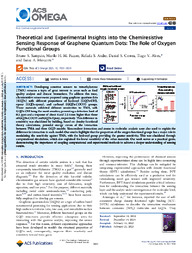Theoretical and Experimental Insights into the Chemiresistive Sensing Response of Graphene Quantum Dots: The Role of Oxygen Functional Groups.
Theoretical and Experimental Insights into the Chemiresistive Sensing Response of Graphene Quantum Dots: The Role of Oxygen Functional Groups.
Autoria: SAMPAIO, B. S.; FACURE, M. H. M.; ANDRE, R. S.; CORREA, D. S.; ALVES, T. V.; MERCANTE, L. A.
Resumo: ABSTRACT: Developing sensitive sensors to trimethylamine (TMA) remains a topic of great interest in areas such as food quality analysis and disease biomarkers. To address this issue, chemiresistive sensors were proposed using graphene quantum dots (GQDs) with different proportions of hydroxyl (GQDs-OH), epoxy (GQDs-epoxy), and carboxyl (GQDs-COOH) groups. These materials exhibited different sensitivities to TMA, with GQDs-OH being the most sensitive, presenting a detection limit of 0.3 ppm and a response of about 4 and 2.5 times higher than those of GQDs-COOH and GQDs-Epoxy, respectively. This difference in sensitivity was elucidated by building, based on density functional theory calculations, potential energy curves of the interaction between TMA and three GQD models. Noncovalent interaction and atoms in molecular analysis were also used to explain the difference in interaction in each model. Our results highlight that the proportion of the oxygen functional groups has a major role in modulating the sensitivity against TMA, with the hydroxyl group providing the greater sensitivity. This was elucidated through computational simulations, which also explained the lower sensitivity of the other materials. Our work serves as a practical guide, demonstrating the importance of coupling computational and experimental methods to achieve a deeper understanding of sensing .
Ano de publicação: 2025
Tipo de publicação: Artigo de periódico
Unidade: Embrapa Instrumentação
Palavras-chave: Computational Simulations, Synthesis of the GQDs
Observações
1 - Por padrão são exibidas publicações dos últimos 20 anos. Para encontrar publicações mais antigas, configure o filtro ano de publicação, colocando o ano a partir do qual você deseja encontrar publicações. O filtro está na coluna da esquerda na busca acima.
2 - Para ler algumas publicações da Embrapa (apenas as que estão em formato ePub), é necessário ter, no celular ou computador, um desses softwares gratuitos. Sistemas Android: Google Play Livros; IOS: iBooks; Windows e Linux: software Calibre.
Acesse outras publicações
Acesse a Base de Dados da Pesquisa Agropecuária (BDPA) para consultar o acervo completo das bibliotecas da Embrapa.

